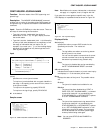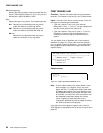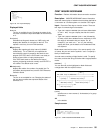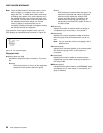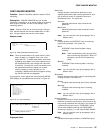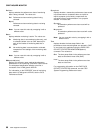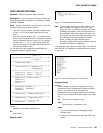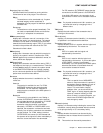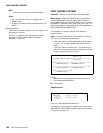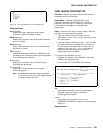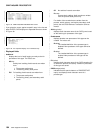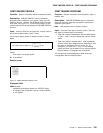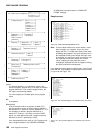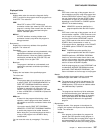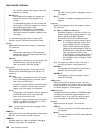CEMT INQUIRE NETNAME
Purgetype (
input only field
)
specifies whether the transactions running with the
named terminal are to be purged. The values are:
PUrge
Transactions are to be terminated only if system
and data integrity can be maintained. A
transaction is to be purged if its definition specifies
SPURGE=NO.
Forcepurge
Transactions are to be purged immediately. This
can lead to unpredictable results and should be
used only in exceptional circumstances.
REMotesystem(
value
)
displays the 4-character name of a connection, if the
subject of the inquiry is a remote terminal. The named
connection can be either a connection entry that links
towards the terminal-owning region (TOR), or an indirect
connection that provides the netname of the TOR.
Otherwise this field is blank.
RNAme(
value
)
displays the 4-character name by which this terminal is
known in the system in which it is defined (the TOR).
RNAME applies only to terminals defined as remote; for
others, blanks are displayed.
RNEtname(
value
)
displays the 8-character netname of the owning TOR, if
the subject of the inquiry is a remote terminal. If this field
is blank and the terminal is remote, the system named
in the REMOTESYSTEM field has not been installed,
and no value was specified for the REMOTESYSNET
option when the terminal was defined.
Servstatus
displays whether the terminal is available for use. The
values are:
Inservice
The terminal is available for use. For VTAM,
INSERVICE means that the terminal can be
ACQUIRED. For IRC sessions, INSERVICE
means that the connection to the MRO partner is
INSERVICE.
Outservice
The terminal is not available for use. Setting a
terminal OUTSERVICE means that the terminal
can no longer be used by transactions. If PURGE
or FORCEPURGE is also specified, any
transaction using the terminal is terminated
abnormally. If PURGE or FORCEPURGE is not
specified, the transaction is allowed to terminate
normally, but no further transactions are allowed to
use the terminal. For VTAM, setting a terminal
OUTSERVICE also causes it to be released and
the operator to be signed off, either immediately or
when the current transaction has terminated.
For IRC sessions, OUTSERVICE means that the
connection to the MRO partner is OUTSERVICE.
In an LU6.1 ISC session, the connection is set
OUTSERVICE if there are no allocatable sessions
left.
Note: For physical terminals and LU6.1 sessions, you
can reset this value by overtyping it with a
different value.
TAsk(
value
)
displays the task number of the transaction that is
running on this terminal.
TErminal(
value
)
displays a 4-character terminal identifier (1-4 characters)
as specified in an installed terminal definition.
Termstatus (
vtam only
)
displays whether CICS is in session with the logical unit
represented by this terminal. The values are:
ACquired
CICS is in session with the logical unit
represented by the terminal.
RELeased
CICS is not in session with the logical unit
represented by the terminal. If you set this option
to RELEASED, a session is terminated
immediately if you also specify the PURGE option,
otherwise the session is terminated when the
current active transaction finishes.
Note: For physical terminals and LU6.1 sessions, you
can reset this value by overtyping it with a
different value or with:
COldacq
This is a special form of ACQUIRED,
where no resynchronization is required. If
the previous session abended, the use of
COLDACQ overrides CICS integrity
control. This could lead to integrity
problems. Also, you should check the
CSMT log for an activity keypoint after the
restart of a session following a CICS
failure. If there is no activity keypoint, you
should issue COLDACQ again after the
next emergency restart.
TRansaction(
value
)
displays a 4-character string indicating the name of the
transaction currently being processed with this terminal
as its principal facility or as a secondary facility.
Ttistatus
displays whether the terminal can be used by the
transactions that are initiated from this terminal. The
values are:
TTi This terminal can be used by transactions.
Chapter 11. Master terminal CEMT 101



